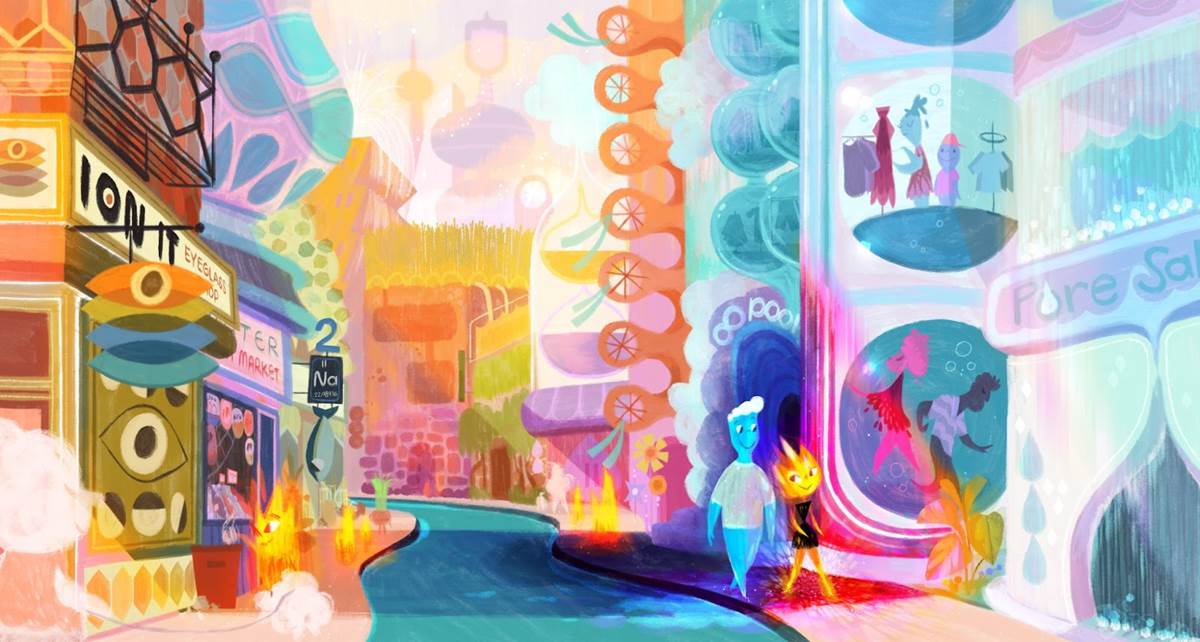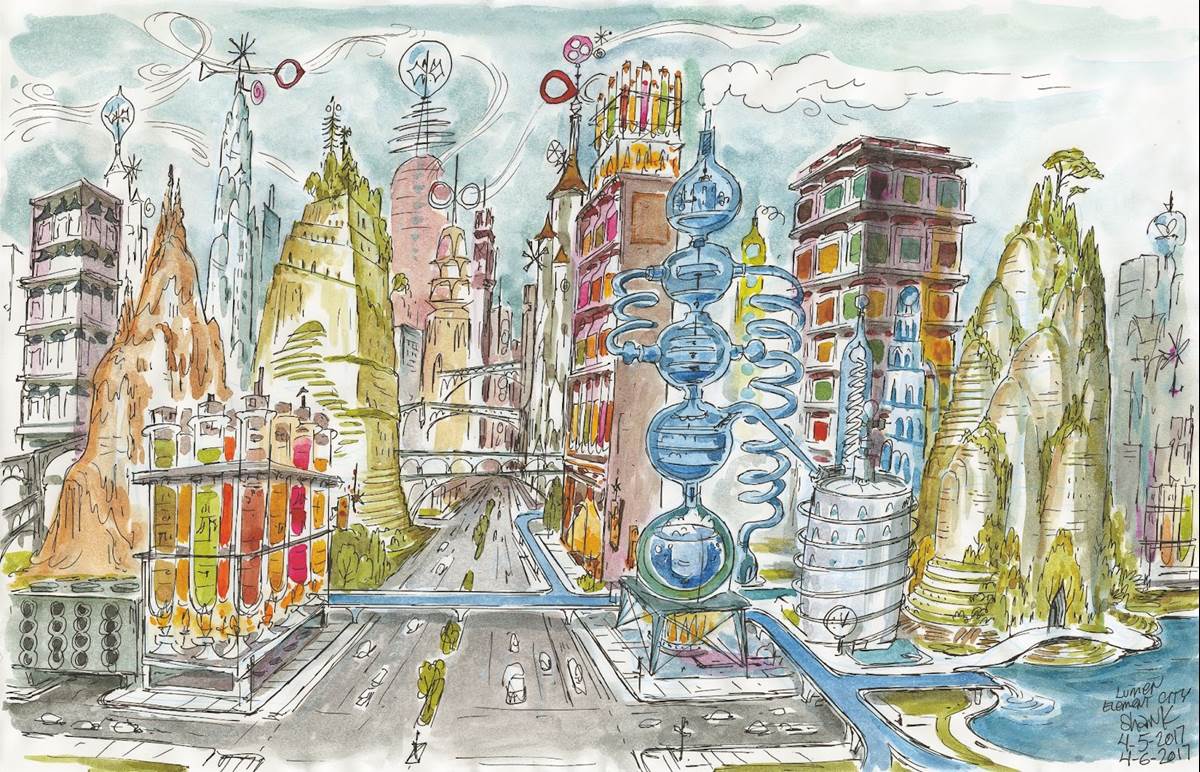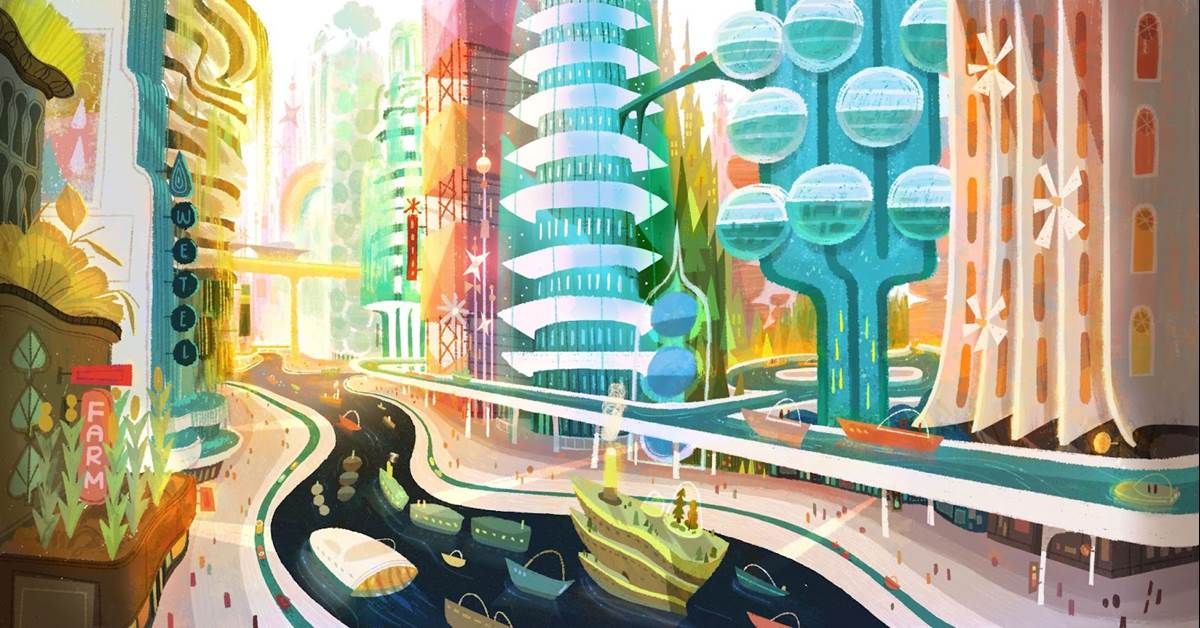“It was a phrase that I had heard from George Lucas on the making of Star Wars,” shared Elemental director Peter Sohn during an early press day for Pixar’s newest film. He was referring to a concept called “Immaculate Reality,” which he employed in the development of Element City, the story’s setting. Pixar traces its origins to Lucasfilm, but George Lucas’ approach to world-building is still employed at the company more than 35 years after Lucas sold the tech startup. “They were designing things knowing that they had a history to them, but the audience would never get to know that history. But because of that, it would make the world feel more real because things had a history to them.”
The history of Element City isn’t presented in the film, but just like a planet in Star Wars, Pixar created one for the story. The city was founded by water and earth, who came together to create a delta that would also attract air. As the city prospered, it attracted a community of fire, but the city wasn’t really built with fire in mind. Like Lucasfilm’s “Immaculate Reality” principal, Pixar’s own “Truth in Materials” philosophy had to be applied. During the press day, production designer Don Shank discussed some of the real-world physics that had to be worked out in order to create a physical space where living elements could live. The lead character, Ember, lives in Fire Town, where buildings are made of inflammable materials or ones that are even made by fire, like ceramics, terracotta, and metal. Water lives in tall, glass buildings in floating apartments that resemble Galileo thermometers. And earth lives in buildings that look like terraced farms or flowering plants.
The history that went into Elemental and its setting was very personal to the Pixar director, who got to grow this film from concept to completion, a very different experience from his feature debut (The Good Dinosaur). “My parents had come here from another place, a foreign place, to make a better life for us,” Peter Sohn explained. “It's something that I grew up not really understanding until I became an adult, where I really began to appreciate that, and so it was all tied from a personal experience.” In the film, Ember is the first-generation daughter of two immigrant parents who left their home behind to establish a new life in Element City with a store of their own. “[My parents’ shops] were all in immigrant neighborhoods, and so that's all I had known. All sort of poor families, but they were all from another place, and so you were just in this very rich, diverse community. That really affected me growing up… Once I thought about the elements as separate communities, I was trying to capture the idea of people that had come from other places that have gathered to create a life for themselves. That was the emotional hook for me.”
“For a foreigner like my parents, I always remember them talking about like, oh, it was uncomfortable for them to take the subway because they couldn't read the maps in English,” Sohn continued, with Element City’s own mass transit called the Wetro, a floating train on elevated canals. “There were always these tiny little challenges throughout the day that made you feel like that this wasn't your home. And so what was interesting about that for fire is that if they went into a city, what would make those same sort of connections that my parents had? And making it like water, a city that was built off of water infrastructure, felt like the first sort of step of, oh, clearly visually, you could see how that might not be a great place for fire. So everything is based on that storyline of Ember and her family's journey start to help build the city.”
Anyone whose ever been to New York City will feel its connection to Element City in more ways than one, including districts that were shaped by the culture of the immigrants who made it their home. But NYC wasn’t the only real city that Peter Sohn and his team looked at. “We saw architecture from around the world,” he shared. “We were looking a lot at Port Cities in terms of trying to find gateways into a country, understanding how a country welcomes people in, other immigration hubs around the world. And that was just for the port, but then iconic buildings that felt romantic or beautiful or memorable. Literally, we had seven years on this film. We researched almost everything, buildings in Brazil that had wonderful earth designs in them and then really slick buildings in the Middle East that had watery shapes through them. We scoured everything.”
Because of his upbringing, when Peter Sohn was a child learning about the periodic table of elements, the grid reminded him of a New York City apartment building. That thought never left him, and as he began to shape this opposites attract story about a girl made of fire, the natural opposite was a boy made of water. “I could feel the conflict and the fun that could be from there,” Peter said of the two elements. “That also started tying to my own life with my wife, having married someone that wasn't Korean, and the culture clash that created with my own family. And then, on top of that, when I was growing up, I didn't really appreciate all the things that my parents had gone through. I mean, they had gone through a war, they came to the country without any English. And there were a lot of obstacles for them that, as a kid growing up in New York, I just didn't understand or empathize with. And then the older I get and with every milestone that passes, the more I really begin to be amazed by what they were able to do with so little and that I could not do that myself now as a father. And that gratefulness became this part to the whole thing that tied all of it together.”
Sadly, over the seven years that Elemental was in production, both of Peter Sohn’s parents passed away in the midst of creating a story that was not only his and theirs but also relatable to many immigrants and their children. “My experiences of growing up in New York and some of the xenophobia that my parents and I faced were all issues that were more personal than political,” he said. “They were all things that I, to this day, struggled with. And I'm trying to find a way to talk to my own kids about them… The idea of this movie is meant to be a very hopeful one. On its nose, it's a very colorful film with a lot of disparate communities. But that was the fun of it, that visually you could see immediately how some of these communities can be very hopeful and something to strive for. So it was really about putting hope forward.”
“That personal experience resonated with a lot of people, our coworkers, and colleagues,” added producer Denise Ream. “So many people at Pixar are first- and second-generation immigrants. So we ended up having a lot of those people work on the movie, and that added texture and authenticity.”
Directing a team that understood that immigration story firsthand also helped Peter Sohn as he lead them through a deeply personal story while losing the parents who inspired it. “It's just been about wanting to thank our parents for the sacrifices that they've made,” he said of the community of immigrants who worked on Elemental. “When I get lost, I come back to it. As difficult as this film can be, I come back to that simple little guiding thing. I lost both my parents here… I feel like the crew helped me understand that we could all connect to it and make it feel universal. The point for me is just to make connections with the film so that we can all connect to something that feels real and truthful and deepen ourselves, from kids to adults, families, and everybody, to try to find something that can straddle all of that.”
While Elemental and its setting support the story of the daughter of immigrants finding her soul mate in the most unlikely place, like all Pixar films, it’s a film that the whole family can enjoy when it arrives in theaters on June 16th.
(Please note this article contains affiliate links. Your purchase will support LaughingPlace by providing us a small commission, but will not affect your pricing or user experience. Thank you.)



